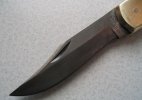Was the LB7 (introduced in 78, if I understand correctly) the first "deeply" hollow grind production knife?
I've become interested in the history of the hollow grind and how and when it became popular and why.
My hunch is that aesthetics are (were) driven by flukes of manufacturing and that something changed in blade grinding machinery that allowed for cheaper mass production of hollow grind blades like that on the LB7.
Can anybody speak about the grinding machinery that was used on knives like the LB7 and contrast that to the kinds of machinery that was used by Schrade to produce the flat and sabre ground blades in the pre 78 years?
I've become interested in the history of the hollow grind and how and when it became popular and why.
My hunch is that aesthetics are (were) driven by flukes of manufacturing and that something changed in blade grinding machinery that allowed for cheaper mass production of hollow grind blades like that on the LB7.
Can anybody speak about the grinding machinery that was used on knives like the LB7 and contrast that to the kinds of machinery that was used by Schrade to produce the flat and sabre ground blades in the pre 78 years?


